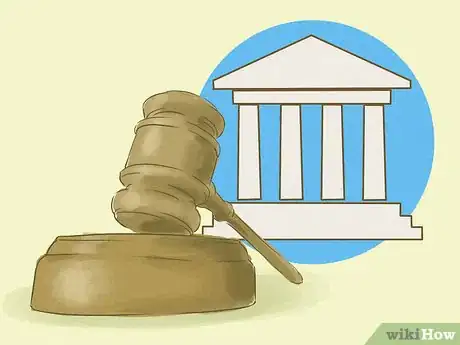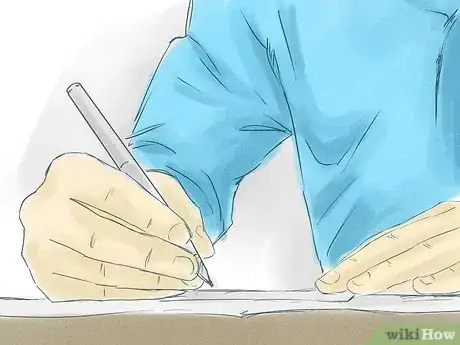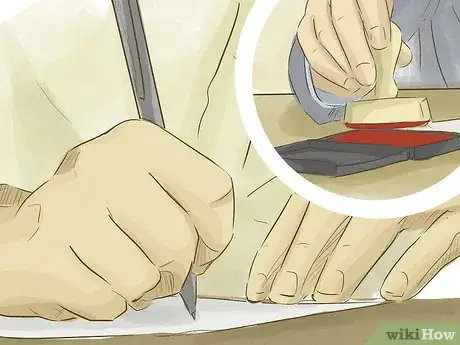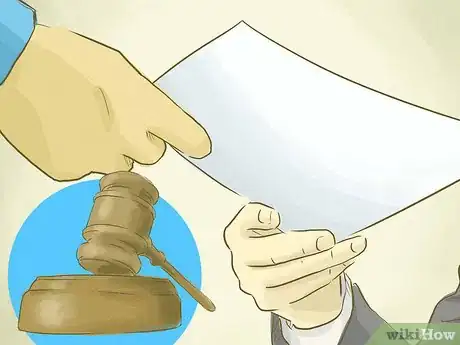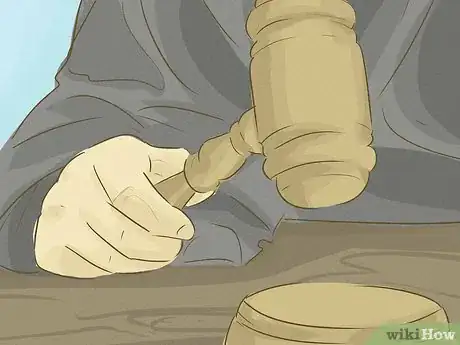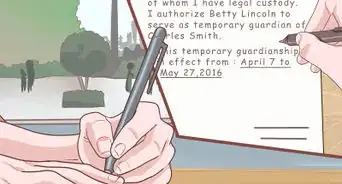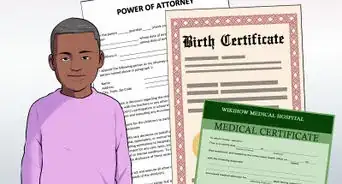This article was written by Jennifer Mueller, JD. Jennifer Mueller is an in-house legal expert at wikiHow. Jennifer reviews, fact-checks, and evaluates wikiHow's legal content to ensure thoroughness and accuracy. She received her JD from Indiana University Maurer School of Law in 2006.
There are 9 references cited in this article, which can be found at the bottom of the page.
This article has been viewed 42,098 times.
Normally, a contested child custody case can last several months. However, there are times when a determination must be made more quickly to protect the health and safety of the child or children in question. Every state has provisions for seeking temporary or emergency child custody if you believe the child is in danger, provided certain conditions are met. Emergency custody only lasts until a full hearing on the underlying custody case is completed.[1] Before you start, you should consider hiring an attorney, or at least consulting one, for advice in your situation.
Steps
Preparing Your Emergency Petition
-
1Understand what your state considers an emergency. Because of the immediate nature of emergency orders, they typically are not granted absent immediate danger to the child.
- Temporary custody orders can have traumatic effects on children, and potentially violate the other parent’s due process since the judge grants them without hearing from the other side.
- Courts require a real emergency to consider emergency petitions, typically defined as a substantial risk of physical or sexual abuse or neglect while with the current caretaker.[2]
- In many states, an emergency order also may be granted if you have reason to believe the other parent plans to take the child to another state or country without your consent.
- Some jurisdictions provide an expedited process if you have an urgent situation that requires custody to be resolved more quickly than normal, but the issues don’t rise to the level of an emergency.[3]
-
2Review the limits of an emergency custody order. Emergency custody orders usually only serve to remove the child from imminent danger while full custody is litigated.
- If the judge grants your emergency petition, you’ll still be required to go through a full custody case to get a permanent order. A temporary or emergency order won’t last indefinitely.
- If your emergency petition is granted, the court will schedule a hearing as soon as possible to review testimony and evidence from both sides regarding permanent custody of the child.[4]
- You can still file for permanent custody even if the judge denies your emergency petition.[5]
Advertisement -
3Make sure you are the right person to file the petition. In most states, only a parent, grandparent, or someone who has served as a legal guardian for the child can file an emergency custody petition. Check your state’s law or speak to your attorney or someone at your local self-help center to make sure you can file.
- If you’re not legally allowed to file an emergency custody petition to gain temporary custody of the child, but you believe the child is in imminent danger, consider calling local law enforcement or the nearest child protection agency.[6]
-
4Locate the appropriate court. You need to file your petition in the county or parish where the child lives.
- On the website of your state’s highest court, read through the description of your state’s court system until you find the court that deals with child custody. Typically it will either be a family court or a court of general jurisdiction.
- If you’re having trouble figuring out which court you need to use, someone in the civil court clerk’s office may be able to assist you.
-
5Complete the required forms. Most states provide pre-prepared forms for emergency custody petitions -- all you have to do is fill in the blanks.
- You can find these forms on the court’s website, at your local clerk of court’s office, or at family law self-help centers.
- Typically, you’ll be completing a packet of forms that includes an emergency custody petition, an emergency pick-up order directing local law enforcement to take custody of the child, and a summons or citation.
- In some states, you can use an interactive online program to create documents tailored to your specific circumstances.
Filing Your Emergency Petition
-
1Sign your petition in front of a notary. In many states, you must sign your petition in the presence of a notary before you file it. Make copies of all documents after you’ve signed and notarized them.
- If you’re not sure where to find a notary, ask at the clerk’s office or search online.
- The notary will charge a fee for his/her services.
-
2File your documents with the clerk of court. After signing your documents and having them notarized if necessary, take them to the clerk’s office and give the originals to the clerk for filing.
-
3Pay the filing fee. Although fees vary widely among states, expect to pay at least a hundred dollars.
- The court probably will charge you an extra fee, in addition to the standard fee to file for custody, if you’re filing an emergency petition. This additional fee can range anywhere from $50 to more than a hundred.[7]
- If you cannot afford the fees, you can apply for a waiver. If the waiver is not granted, you’ll still have to pay the filing fee before the judge will consider your petition.[8]
- After the fees are paid, the clerk will stamp your documents “filed” with the date and the clerk’s initials.
- If you ask, the clerk may be willing to stamp your copies as well. Otherwise, you can make copies of the stamped sheets and attach them to your copies.
-
4Go to the emergency hearing, if required. In some circumstances, the judge will want to speak with you to get additional information about the risk to the child.
- Emergency petitions often are addressed the same day they’re filed.[9]
- Be honest and respectful when speaking to the judge, even if (s)he asks critical questions or denies your petition.
- If the judge grants your petition, (s)he will sign the emergency order and the order for law enforcement. The court will then schedule a full hearing as soon as possible to allow the current caregiver to respond to your allegations.[10]
- When the judge signs the order, the clerk will sign or issue a summons or citation and service of process. There will probably be an additional fee for this.
-
5Pick up the child. After the judge signs the order, local law enforcement is responsible for picking up the child.[11]
- If you attempt to pick up the child yourself, you risk violating laws against the kidnapping and removal of children by non-custodial parents, even if you have a court order.
- You will be contacted by law enforcement once they have the child and told how to take custody.
-
6Serve the other parent. You cannot do this yourself. The clerk’s office may have a list of process servers in your area, or you can contact your local sheriff’s office.
- The other parent typically must be served at least two weeks before the hearing is scheduled. The judge will tell you if you need to get the documents served more quickly given the expedited nature of the emergency custody order.[12]
- You’ll have to make additional copies of the documents you filed to serve on the other parent, along with the summons and service of process.
- Some courts require you to file proof of service of process after you've had the other party served. In other courts the process serving company will file the necessary proof with the clerk's office for you. Ask at your clerk's office if you're not sure.
Obtaining Regular Custody
-
1Participate in the pre-trial discovery process. Before the hearing, both sides will gather information and evidence to argue their respective cases. At this point you should consider hiring an attorney, if you haven't already, to help guide you through this complicated process.
- During the discovery process, you can require the other party or potential witnesses to provide you with copies of documents, allow you to inspect items or property, or require them to answer written or oral questions under oath.
- You also may require the other party or the child to undergo psychological testing or other evaluations by a professional. After that evaluation, the professional would make a recommendation to the court as to what (s)he thought was in the best interests of the child.[13]
- You’ll need to issue subpoenas for any witnesses you want to come to the hearing for questioning. Although you may be able to download and print a subpoena form for free, you’ll have to pay if you want to send the subpoena to the witness using registered or certified mail.[14]
-
2Make any necessary disclosures. Throughout the case, both parties must make certain disclosures, both to each other and to the court, regarding information such as expected witnesses, exhibits and evidence to be presented.
- The court also may require financial affidavits if support of the child is at issue.
- Pre-trial disclosure gives each side the opportunity to examine the proposed evidence and object to it if necessary. Failure to disclose evidence or witnesses within a certain period of time before the hearing may mean you cannot present them.
-
3Comply with any required mediation. Many states require some form of mediation in family law cases. Mediation involves a neutral third party working to bring both sides to an agreement on the issues in a less formal environment than court.
- Rules regarding witnesses and evidence tend to be more relaxed than in the courtroom setting, and the parties work together to find common ground.
- In most states, a judge can excuse a particular case from the mediation requirement if (s)he believes there is a risk to either party or the mediation would be pointless.
- Mediation often is waived in emergency situations.
-
4Attend the contested custody hearing. On the day of your hearing, arrive in court at least 15 minutes before your hearing is scheduled. If you’ve hired an attorney, (s)he may want to meet with you before the hearing for some last-minute preparation.
- Dress conservatively, wearing a suit or dress if possible. If all you have are more casual clothing, make sure what you’re wearing is clean, not revealing, and without prominent advertising logos or offensive slogans.
- Speak only to the judge, and only when the judge asks you a question. Don’t interrupt or speak out of turn, and don’t speak to the opposing party.
- The judge will hear each party’s arguments and give each of you the opportunity to present evidence, witnesses, and exhibits to back up your claims.
- After both sides have rested their cases, the judge will make his/her decision.
- Typically the party who wins is responsible for preparing the final order, which the judge will sign. You should come to the hearing with a draft order in anticipation of this.
-
5Get the final order. Once the judge signs the order, you can get a certified copy of the signed order from the clerk. You may have to pay a fee for this copy.
- If you disagree with the judge’s ruling, you typically have 30 days to file a Notice of Appeal with the trial court and begin the appeal process.[15]
References
- ↑ https://www.womenslaw.org/laws/nc/custody/who-can-get-custody-and-visitation#content-8137
- ↑ https://www.womenslaw.org/laws/nc/custody/who-can-get-custody-and-visitation#content-8137
- ↑ https://www.courts.phila.gov/pdf/brochures/dr/custody-brochure.pdf
- ↑ https://www.courts.phila.gov/pdf/brochures/dr/custody-brochure.pdf
- ↑ http://www.gumandhillier.com/emergency-child-custody-orders/
- ↑ https://www.courts.phila.gov/pdf/brochures/dr/custody-brochure.pdf
- ↑ https://www.avvo.com/legal-guides/ugc/costs-of-a-child-custody-case
- ↑ https://www.courts.phila.gov/pdf/brochures/dr/custody-brochure.pdf
- ↑ https://www.courts.phila.gov/pdf/brochures/dr/custody-brochure.pdf
- ↑ https://www.courts.phila.gov/pdf/brochures/dr/custody-brochure.pdf
- ↑ http://codes.ohio.gov/orc/3127
- ↑ http://www.scscourt.org/self_help/family/custody_visitation.shtml
- ↑ http://www.webbfamilylaw.com/CUSTODY-LITIGATION.pdf
- ↑ http://www.illinoislegalaid.org/index.cfm?fuseaction=home.dsp_content&contentID=6371
- ↑ http://supremecourt.ohio.gov/LegalResources/Rules/appellate/AppellateProcedure.pdf



